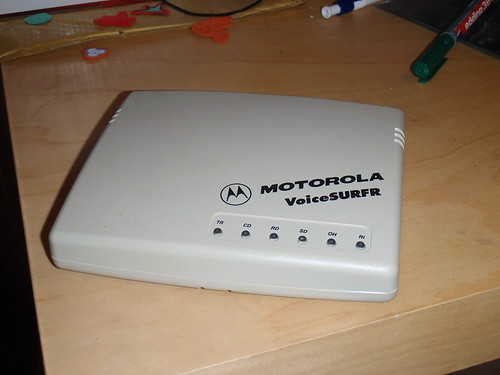When I first had email and an internet connection, it was made possible by using a dial-up modem. These modems were positively snail-like compared to today’s devices. For example, my first modem could transmit data over the telephone line at the blistering speed of 9 kilobytes per second (kbps).
As time went on, I hankered after the new improved version, which could achieve a whopping 28 kbps. And I was beside myself with glee when I discovered that I had saved enough to but the mega-supa-dupa-cool 56kbps.
 A 56 kbps modem. Photo by Andrew Wrendell http://www.flickr.com/photos/anderew/As well as being slow (although, to be fair, we didn’t know they were slow at the time), dial-up modems carried the major disadvantage of disallowing any phone calls to be made or to come through, because the data was transmitted over the same telephone line intended for making and receiving calls.
A 56 kbps modem. Photo by Andrew Wrendell http://www.flickr.com/photos/anderew/As well as being slow (although, to be fair, we didn’t know they were slow at the time), dial-up modems carried the major disadvantage of disallowing any phone calls to be made or to come through, because the data was transmitted over the same telephone line intended for making and receiving calls.
So, nothing much to miss there. But they did have one major advantage: the noise it made told you whether or not it had connected you. So much better than today’s boring icon-centred approach: you could actually hear the connection being made.
If you wish to hear the sound for yourself, head on over to The Mechanics and Meaning of That Ol' Dial-Up Modem Sound.
Here’s a question: do you think it important to know about the technology that existed before our current technology? I’m not interested in nostalgia (a quick search on this website for ‘nostalgia’ will prove that), but I have a nagging feeling that it’s important to know about our technological past.
If you think so too, have a look at Richard Millwood’s National Archive of Educational Computing. (Check out his blog, A New Learning Landscape, too.)
Have a look, too, at The Museum of Endangered Sounds, to hear, or re-hear, the clicks and buzzes of a bygone era (or several bygone eras to be more precise).
What do you think about all this?

